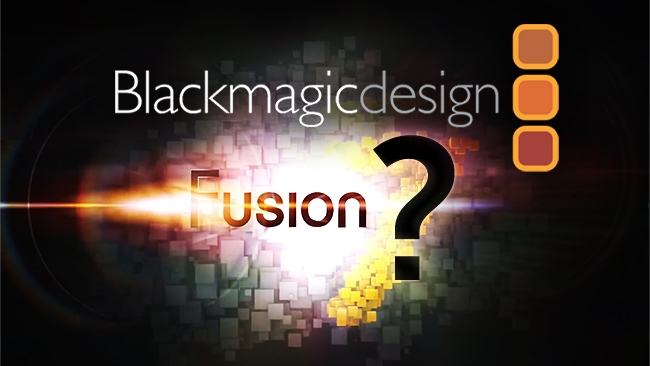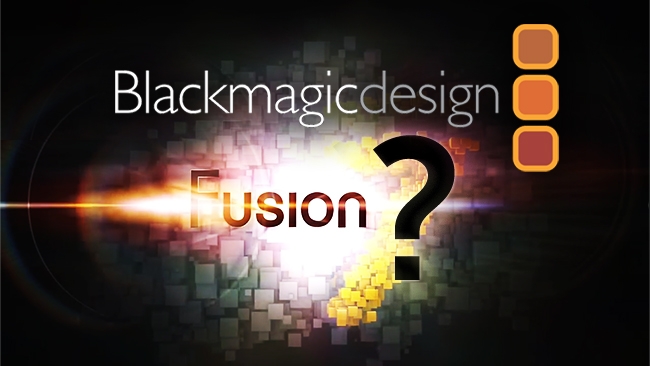

With the acquisition of Eyeon Fusion, Blackmagic is poised to be a major player in VFX and Compositing
Blackmagic has just announced that it has purchased Eyeon Fusion. It's a powerful compositing system (2D and 3D) that's extremely well thought of at the top end of the vfx market. How top end? It's been used recently on blockbuster films including Sin City, Gravity and Spider Man.
Fusion has been developed over a period of a quarter of a century, and has a rock-solid reputation amongst its users.
This is interesting news, but it's very important news as well, because we now know what Blackmagic does with its software acquisitions: it develops them to an aggressive timetable, makes them more accessible (with a better UI and with a better price!) and then builds a whole ecosystem around them.
Before we look more closely into where this purchase will ultimately fit into the Blackmagic line-up, let's look at the product itself.
Fusion was the first "desktop" compositing system, where "compositing" means adding layers of video, still images and mattes together, using a variety of tools like blending, keying, blur and spine-based keyframe animation. Today, it's a deep, complete package that not only works in a 2D space but in 3D as well - absolutely essential to deal with the quantity of 3D material that finds its way into modern films and other productions.
Why has Blackmagic bought Eyeon, the Toronto-based developers of Fusion?
To answer this, just consider the recent history of another company they bought, almost five years ago to the day: DaVinci. Here was an expensive product that had an iron-clad reputation in the industry. Priced to be affordable to only established post houses with the budgets to match their longevity, or as an expensive but essential purchase to new facilities, at the time it seemed an esoteric, left-field acquisition for a company that - rightly or wrongly - was more famous for its cost- effective I/O cards.
The clue to all this is that Blackmagic's CEO, Grant Petty, worked in post production. He's seen the less glamorous side of the business, where typically badly paid junior staff work long hours trying to meet the often unrealistic expectations of their clients. What he's trying to do is make top-end technology accessible to talent at all budgets.
Blackmagic is a big business now, but the core strategy still seems to be based on creative need rather than the short-term quest for revenue. You can see how this has worked with DaVinci Resolve.
At first, Resolve was a surprising addition to the Blackmagic fold. It was high-end software in a sea of affordable products. But now the landscape seems completely different - and it all makes sense. Resolve is an essential "back end" not only the Blackmagic cameras that output raw video, but to almost every other camera, irrespective of the format. Colour correction and grading - creating a special "look" is now as much of the post production process as editing, and Blackmagic has placed Resolve right at the centre by making it more affordable - and by improving it. They've made it better by evolving the UI, by adding more native camera formats, and - this is a big clue to Blackmagic's ultimate aspirations - they've put it on the road to being a fully fledged editor (some would argue that it already is).
Note that it's very unlikely that Blackmagic could have built software like Resolve without buying it. There's just too much expertise and man-years of effort to even get close. But what they have done is to use their own experience of marketing and distribution to turn it into a wildly successful commercial product.
Now we can only speculate what Blackmagic might do with Fusion, but at least we have Resolve to give us some insights.
Luckily, Fusion has a lot in common with Resolve. For a start, it's node-based. It also uses CUDA as a gateway to the abundant GPU power that's available in modern workstations. And the latest version of Fusion has file support for DNG (again, a perfect fit with Blackmagic products).
Over the page, what we think the timeline will be now...
This is what we think might happen
Stage one (Blackmagic actually told us this): it's business as usual for Fusion. Version 7 - a significant upgrade - has just been released, and that will be sold as if nothing had happened.
Stage two (we're completely guessing now): around NAB time, version 7.5 will appear with some fixes and minor tweaks, but, most importantly, it will start to carry Blackmagic branding.
Stage three (we're using our psychic powers...): after some more minor releases, at NAB 2016, a completely new version will appear, looking a lot like Resolve, and with seamless round trips for content between the two (now sibling) applications.
We're not going to stick out necks out far enough to predict a stage four...
Somewhere in this sequence of events there will probably be a price reduction. You may also see some of the technology being used in other Blackmagic products in the same way that Live Grading now exists in places in Blackmagic's live production tools.
Compositing is like plumbing: if it all works, you don't see it and you don't think about it. The better it is, the more invisible it is. That's perhaps why compositing software doesn't grab the headlines in the same way that NLEs and Colour Grading software does.
But this deal has the potential to send tremors through the industry, because a top compositing package is about to be made available to a much wider audience. And not only that. This much larger body of users has access to all (not just some) of the right kit to make the films that need compositing software at their core. Need a low cost camera to shoot green screen material? There's the Blackmagic Production Camera and the URSA. Need to create simple or complex composites of the green screen footage and 3D models? There's Fusion. Need to grade it? There's Resolve. Need to edit it? There's Resolve as well.
You can probably see what they've done there.
(Still not sure what Fusion is? There's a great introductory video over the page)
Tags: Post & VFX


Comments